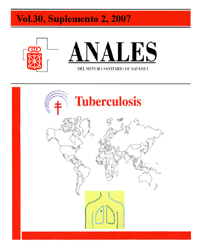Tuberculosis in patients with HIV infection
Keywords:
Tuberculosis. SIDA. VIH. Tratamiento. Micobacterias no tuberculosasAbstract
Tuberculosis is a clear example of infection that requires cellular immunity for its control. The spread throughout the world of the Human Immunodeficiency Virus (HIV) resulted in its interaction with tuberculosis altering the descending curve of the latter disease in some developed countries, and brought an aggravation of the problem in other countries with few economic and health resources and where tuberculosis was endemic. HIV increases the risk of reactivation of latent tuberculosis infection and accelerates progression after infection or reinfection; on the other hand, TB aggravates the prognosis of patients infected with HIV. This article sets out the differential aspects in the clinical manifestations of TB amongst populations with and without HIV infection; we also comment on some special characteristics in the treatment of tuberculosis in HIV patients. With the exception of primary cutaneous infections produced by accidental inoculation and infantile lymphadenitis, the majority of the cases of disease due to non-tuberculosis mycobacteria (NTM) affect patients with certain predisposing factors. In the case of patients with AIDS, the deep immunological disorder provoked by HIV brings a particular susceptibility to suffering invasive disease due to certain NTM, principally M. avium complex and M. kansasii.Downloads
Downloads
Published
How to Cite
Issue
Section
License
La revista Anales del Sistema Sanitario de Navarra es publicada por el Departamento de Salud del Gobierno de Navarra (España), quien conserva los derechos patrimoniales (copyright ) sobre el artículo publicado y favorece y permite la difusión del mismo bajo licencia Creative Commons Reconocimiento-CompartirIgual 4.0 Internacional (CC BY-SA 4.0). Esta licencia permite copiar, usar, difundir, transmitir y exponer públicamente el artículo, siempre que siempre que se cite la autoría y la publicación inicial en Anales del Sistema Sanitario de Navarra, y se distinga la existencia de esta licencia de uso.








